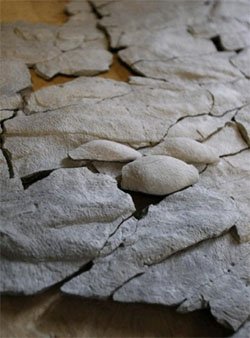Unidentified Fossil Found in Kentucky
An unusual fossil has been found in Kenton County, Kentucky.

AP Photo/The Cincinnati Enquirer, Gary Landers; Image from news.yahoo.com/photos/man-s-fossil-find-stumps-experts-slideshow
Godzillus fossil, substantially larger than ordinary Ordovician fossils, has been reconstructed from many pieces excavated from a road cut in Northern Kentucky.
An unusual fossil has been found in Kenton County, Kentucky. One reason this fossil is interesting is that paleontologists are having trouble identifying it. Ron Fine, the amateur paleontologist who found the fossil, describes it as being three-and-a-half feet wide by six-and-a-half feet long.1 This is quite large for a fossil found in the Kentucky area. University of Cincinnati geologist Carl Brett says, “This is the largest fossil that has ever been extracted from this age of rock in this area or maybe even in the world.”1
Some scientists speculate that it could be biological in nature, such as a microbial debris mat that once floated in a sea, but there is no consensus. These scientists suppose that the Kentucky area was a sea at one time, containing only primitive sea creatures, based upon the types of fossils found in the same rock layer (Upper Ordovician rock sometimes referred to as “Cincinnatian”).
“Secular and creationist scientists agree the fossils in this area were subjected to violent storm conditions. Today, the Cincinnati area is 500 miles from the sea. Secular scientists speculate that the ocean rose such that this region was actually submerged near the coastline.
Biblical history of the global Flood explains these findings—the violent storms, the submergence of the whole region, the types of fossils, and the patterns of burial. Ordovician rock, like the Cambrian layer just below it, is deep in the geologic column and contains fossils of the first creatures to be torn from their habitats and catastrophically buried during the global Flood. As the fountains of the deep broke up (Genesis 17:1), volcanic activity would have generated violently surging ocean waters initially destroying and burying sea creatures living on or near the sea bottoms. These are just the sorts of creatures preserved in the Cincinnatian strata. The geologic column doesn’t tell us when these creatures evolved but rather when they died and were buried in the Flood. Much of the geologic column is a timeline of the tumultuous Flood year in earth’s history, not a timeline of the evolutionary emergence of life.”1
– Dr. Elizabeth Mitchell
For more information, please see:
Dr. Elizabeth Mitchell, News to Note, April 28, 2012, Answers in Genesis, http://www.answersingenesis.org/articles/2012/04/28/news-to-note-04282012.
Recommended Resources
- © 2024 Answers in Genesis
- Privacy Policy
- Contact
- About



